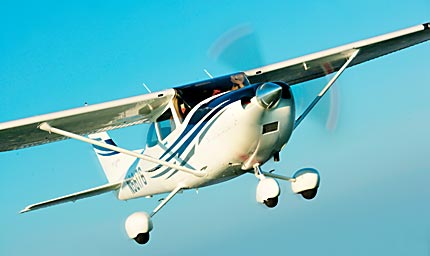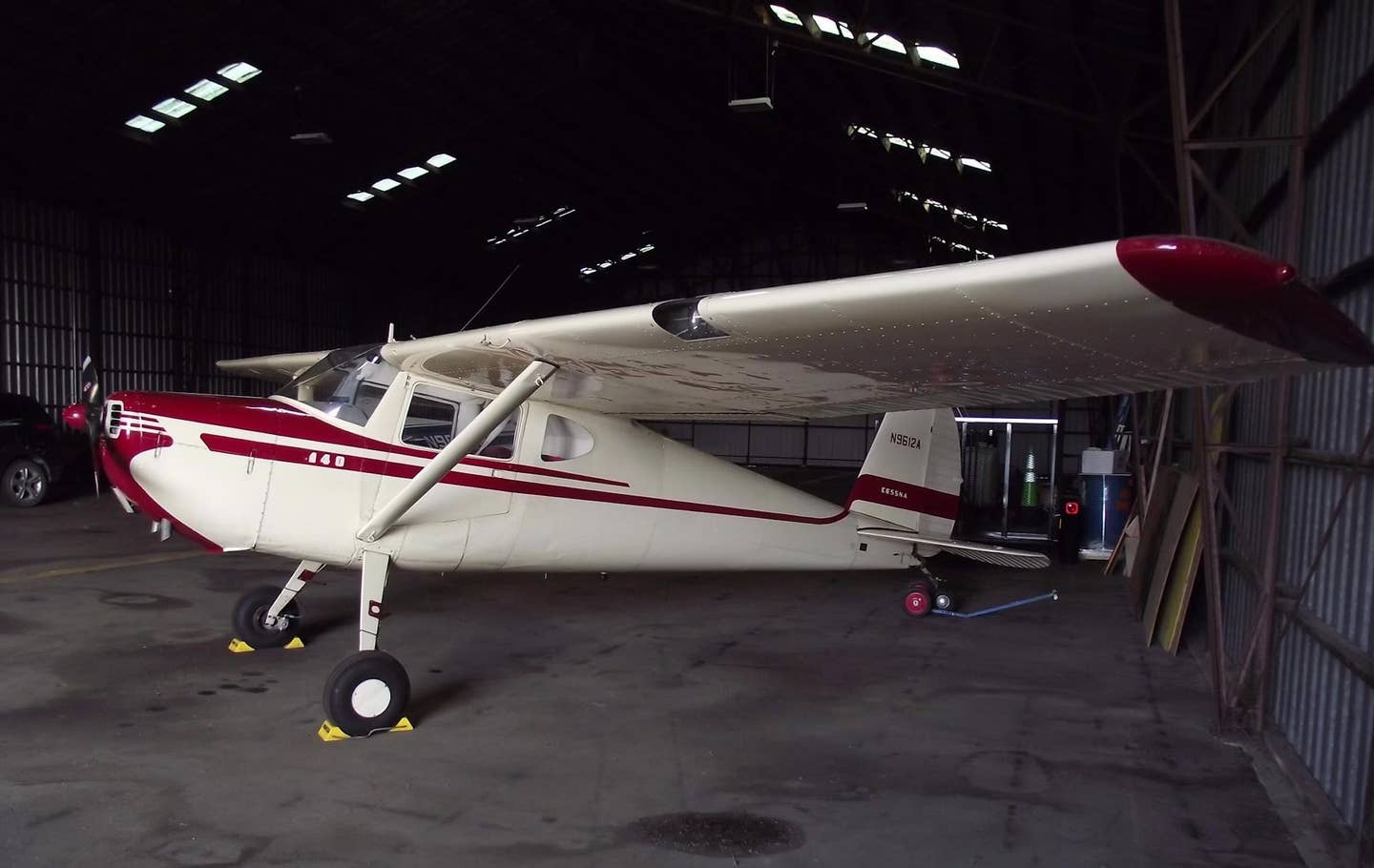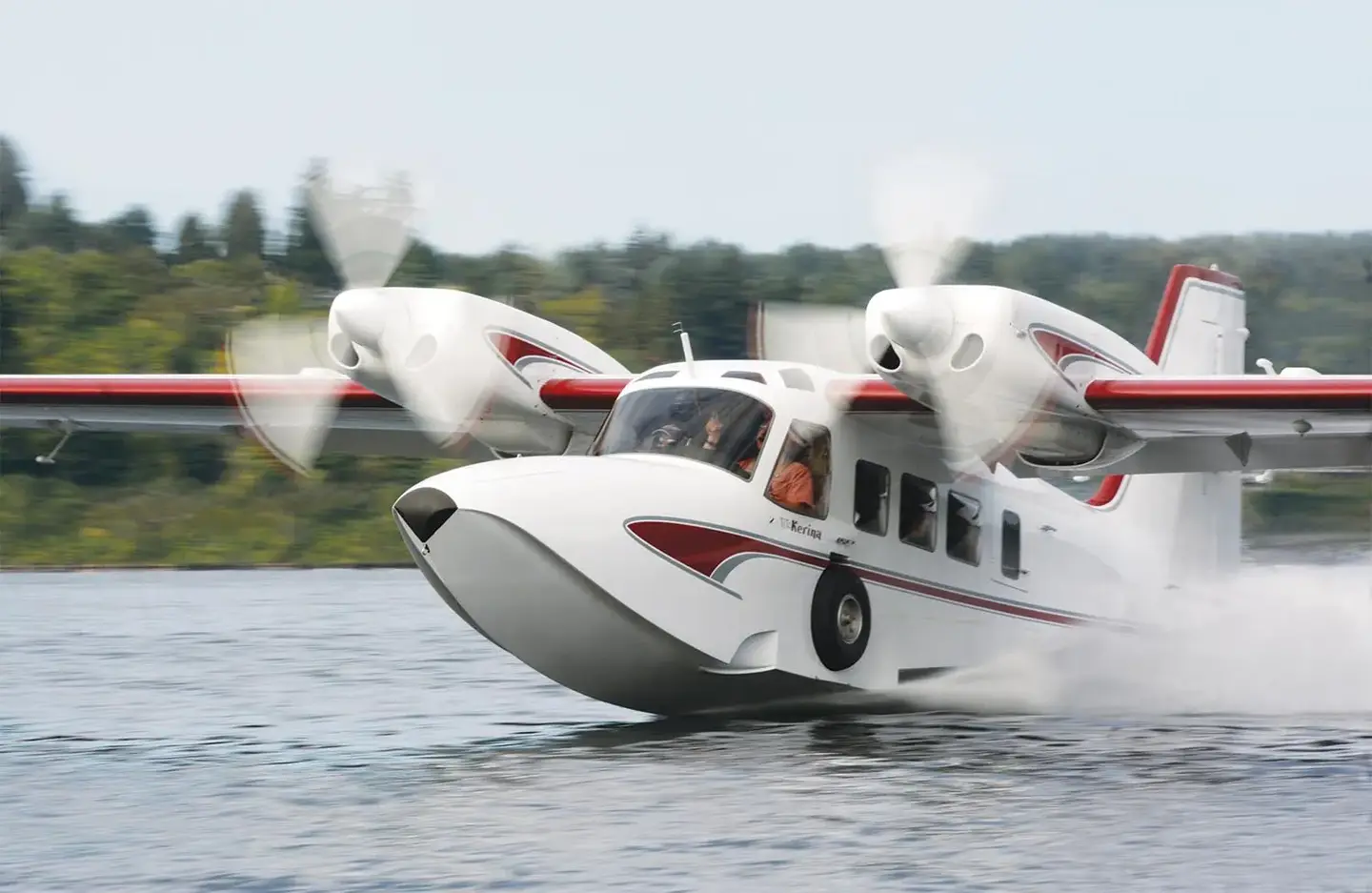Cessna Turbo 182
This Skylane develops full power all the way up to 20,000 feet
 This Skylane develops full power all the way up to 20,000 feet. Like many of you, I've logged my share of hours in C-182s of one description or another, fixed gear and retractable, normally aspirated and turbocharged. By any measure, Skylanes are nothing short of wonderful machines, blessed with docile handling, reasonable performance, good reliability and (in many cases) true, full-fuel, four-place capability.
This Skylane develops full power all the way up to 20,000 feet. Like many of you, I've logged my share of hours in C-182s of one description or another, fixed gear and retractable, normally aspirated and turbocharged. By any measure, Skylanes are nothing short of wonderful machines, blessed with docile handling, reasonable performance, good reliability and (in many cases) true, full-fuel, four-place capability.
These days, creature comforts are generally excellent, regardless of the size of your creatures, the avionics suite is nothing short of amazing, and the airplane continues to carry a phenomenal payload. Still, position an old and a new Skylane side by side in bare aluminum trim, and you might be hard-pressed to tell the difference. Rumors have been flying for several years about Cessna's all-new, four-place piston single, but until that taxis up onto the ramp, the Skylane and Turbo Skylane represent the state-of-the-art from the Independence, Kan., manufacturer.
Just as the Cub was the generic airplane of the ’30s and ’40s, and the butterfly-tail Bonanza dominated the '50s and ’60s, the Skylane has come to be regarded by many as the definitive general-aviation design of the ’70s and ’80s. The C-182 has evolved into a handsome package that continues to endear itself and give the competition a run for the money, specifically because the basic design hasn't changed.
The big innovation for 2005 is Garmin's remarkable G1000 glass cockpit. The talents of the G1000 do-everything navcom and instrument system have been extolled before, so we won't belabor the point, but it's hard to imagine a communication and navigation system with more capability.
Garmin's G1000 combines aircraft attitude and heading, and all flight instrument indications, communication, VHF and GPS navigation, moving map, transponder function, terrain and weather warnings and all engine indications. The bright, multi-colored, two-tube primary and multi-function display is more reminiscent of what you'd expect in an Airbus 330 than a general-aviation, single-engine airplane. There's nothing amateurish about the display, but modern pilots might be tempted to look for the coin slot to play Pac-Man.
An airplane's very basic aerodynamic innovation and power improvements aren't a bad thing when you stop and think about it, assuming you got it right the first time. Cessna did. Like the DC-3 and Boeing Stearman in other aviation markets, the venerable Skylane is far from perfect, but almost a half-century after its introduction, it continues to offer perhaps the best combination of simplicity, performance, comfort, economy and payload in the industry.
If the Skylane is one of the world's definitive singles, the Turbo Skylane represents the best of the best. In Western skies where runways often perch a mile or more above sea level, the trend is definitely turbos. Combine a 90-degree F summer day with the mile-high field elevation of Albuquerque, N.M., or Denver, and many normally aspirated airplanes simply need not apply.
Cessna uses essentially the same injected, 540-cubic-inch Lycoming engine in both the normally aspirated and turbocharged models, but the sloped controller on the heavy-breathing Lycoming TIO-540-AK1A maintains full-rated power (235 hp) all the way to its maximum certified altitude of 20,000 feet, so high-density altitudes are less of a challenge.
The Cessna store near me is Tom's Aircraft in Long Beach, Calif., one of the world's largest piston Cessna dealers (with about 45 airplanes delivered in 2004). Company president Tom Jacobson put me in touch with Mike Bastien of Huntington Beach, Calif., the new owner of the airplane you see on these pages.
Bastien owns Universal Flooring Systems, a commercial flooring company with contracts up and down the West Coast and as far east as Phoenix. Bastien purchased his new Cessna Skylane in March 2005 specifically to service his company's interests. Like all of Tom's new aircraft, Bastien's Skylane is fitted with the Garmin G1000 system and virtually every other option except ADF and air conditioning, and he purchased the Skylane specifically because of the talents of the Garmin G1000.
"For me, the new Skylane was a great follow-on to my 210 hp Skyhawk XP," says Bastien.
First licensed in 1977, the flooring executive wanted a stable IFR platform to service his projects in San Francisco, San Diego and other locations out West. "I use the airplane probably 99% for business, and once you're trained in the use of the G1000, it makes IFR almost intuitive," explains Bastien.
The list price of the G1000 Turbo Skylane comes out to $340,000. It seems no one buys my old friend ADF ($6,100) anymore, and air conditioning, the ultimate luxury at $24,700, simply isn't necessary on the California coast.
The basic machine also includes a list of standard accoutrements the old Skylane could only dream of. Perhaps the most innovative is the AmSafe Aviation Inflatable Restraint, a system of seat belt-mounted airbags designed to inflate within milliseconds of detecting a 16 G impact. Weight, airframe and certification considerations made it impractical to mount conventional, automotive-style airbags, so Cessna contracted with AmSafe to create a simpler, but similarly effective, method of restraint.
Aircraft speeds can translate to impact G-loads that far outstrip anything you might experience in a car, so you still can't drive head-on into a mountain at cruise, but the AmSafe system will improve survivability in most lesser impacts. Yes, the thick belts are a little clumsier to use, with bulky, decompressed airbags tightly packed across your waist, but it's comforting to know you'll have some protection in the event of a minor impact.
Other nice touches inside the cabin include a 12-volt power outlet, Rosen visors, a classy, floor-mounted chart and cup holder console between the front buckets, and a dramatically improved air circulation system.
Any pilot who has flown a C-182 knows it's little more than a C-172 with a hormone problem, and for that very reason, the big secret to the Skylane's personality is trim. At its full gross weight of 3,100 pounds, the Skylane is 550 pounds heavier than the Skyhawk SP, and the additional weight manifests itself primarily in pitch. The airplane's elevator is notably heavier than that of the Hawk, demanding retrimming for any sudden attitude change, such as a go-around.
The roll rate isn't dramatic, but you wouldn't expect it to be, considering the airplane's mission. As with most current-generation Cessnas, adverse yaw is practically nonexistent, making rudder coordination unnecessary in banks shallower than 30 degrees.
The key to the T182T's personality is the turbo itself. An obvious primary benefit of turbocharging is that, most of the time, you can ignore temperature and field elevation as limiting factors during takeoff and initial climb. The 2005 Turbo Skylane will turn in a 1,000 fpm ascent or more at practically all heights to 10,000 feet, 750 to 800 fpm on up to 20,000 feet.
A turbo also expedites high-altitude operation for those pilots who don't mind sucking on oxygen. A built-in, four-position oxygen system is standard on the Skylane, and the more comfortable, new-generation of cannulas make oxygen use more tolerable than the old, full-face masks. It still dries out your sinuses and throat, but it facilitates operation nearly four miles above the Earth. There are even some O2 systems available that attach an oxygen dispenser to a headset microphone stalk, blowing oxygen directly into the pilot's nostrils and making the process totally transparent. If you fly regularly with a skittish non-pilot, these can be a valuable option.
A turbo also offers the obvious benefit of better speed, but high-altitude flight also provides better VHF radio range, reduced traffic, generally less turbulence and better weather. The use of oxygen does increase operating costs slightly (roughly $4 per passenger per hour), but for many pilots, the benefits outweigh the costs.
Fortunately, the definition of high altitude doesn't have to involve flight levels. The T-Skylane can realize significant performance benefits at non-oxygen altitudes. Max cruise power is listed as 88%, and flying at 12,500 feet with power at the limit, you can expect 159 to 160 knots, depending upon weight. That's easily equal to or better than the best efforts of some retractables: the Commander 115B, Socata Trinidad and Piper Arrow.
Better still, the Skylane's leaf spring steel main gear allows it to land in places where most retractables would fear to roll a tread. Just remember to remove the wheel pants if you fly off-airport. The T182T's bulbous, fiberglass wheel fairings won't tolerate truly rough strips any better than low-hanging gear doors.
If you're willing to strap on a mask and climb to 18,000 feet or more, the Turbo Skylane will turn in an extra 15 knots of cruise and cross-country at better than 170 knots. With 87 gallons in the tanks and a typical burn of 17 gph at high cruise, plan on over 600 nm plus reserve between fuel stops. For those pilots with long-range kidneys to endure eight-hour legs, dramatically reduced power can extend the airplane's reach to more like 1,000 nm.
The turbocharger and associated plumbing does inflict a 100-pound penalty on payload, and the result is the airplane won't lift four folks and full fuel. It's more of a three-place machine with both tanks topped. If you fly with half fuel, however, you'll have allowance for the fourth soul plus a little baggage, and you can still endure for two hours plus IFR reserve.
It wasn't so many years ago that pilots were scared of turbos. TBOs were lower, turbocharged engines ran hotter, fuel burn was higher, maintenance cost more, and pilots were concerned about reliability. A turbo adds complexity, but blower manufacturers have refined and improved their systems so much that turbo TBOs are often the same as the normally aspirated models, the overheating problem has been solved, maintenance is no longer a significant headache on modern turbos and reliability is pretty much the same as on the normally aspirated bird.
The T182T is the best of Cessna's line of evolution. If you want an airplane that will do everything well, it may be the one for you.
Contact Cessna at (800) 4-CESSNA or log on to www.cessna.com.

Subscribe to Our Newsletter
Get the latest Plane & Pilot Magazine stories delivered directly to your inbox






